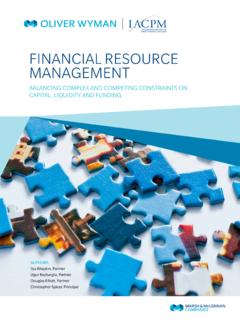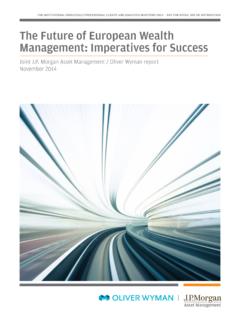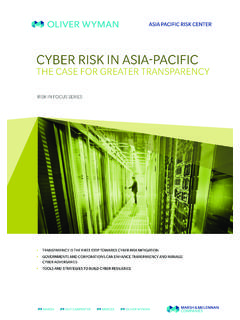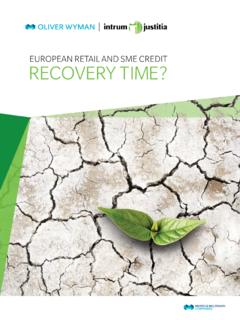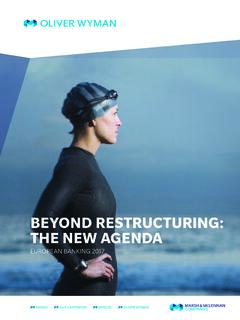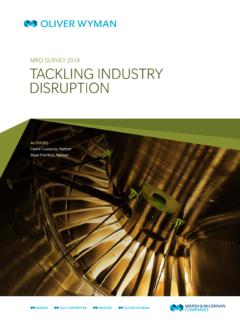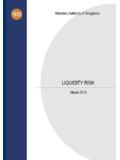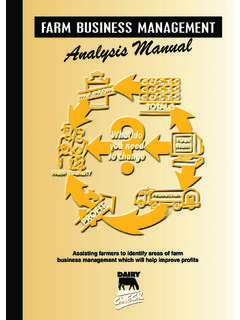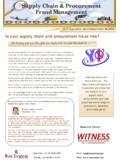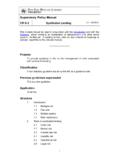Transcription of DEFENDING THE THREE LINES OF DEFENCE - …
1 AUTHORS Michelle Daisley, Partner Sean McGuire, Partner George Netherton, Partner Mark Abrahamson, Principal WHOSE line IS IT ANYWAY? DEFENDING THE THREE LINES OF DEFENCE How do you organise a financial services firm to manage risk effectively? This question is seldom answered without the conversation turning to the THREE LINES of DEFENCE framework. Yet this ubiquitous model receives only lukewarm support from those who use this short note, we argue that there s a self-fulfilling prophecy being played out in the tepid attitude of users. Institutions are adopting the THREE LINES of DEFENCE in a half-hearted way and are accordingly reaping half-baked risk-management believe that the philosophical foundations of the model are sound, but that it will only deliver effective risk management when coupled with a specificity and thoroughness in implementing it that has largely been absent from the industry to date.
2 The challenge for C-Suite executives and board members is to diagnose whether their organisations are truly walking the walk or merely talking the talk. Ambiguity on this topic is dangerous. Putting aside the matter of inefficiency, without a healthy functioning risk-management framework in place, firms can be exposed to risks being taken by a small number of people with asymmetric incentives to the detriment of the business, the customers and the industry. Add to this a false sense of security being provided to the board and supervisors on the comprehensiveness of independent and expert challenge and you have a precarious state of SELF-FULFILLING PROPHECYIn the summer of 2013, the Parliamentary Committee on Banking Standards published their report, and devoted two pages to lambasting British Financial Services firms reliance on The Maginot LINES of DEFENCE . 1 Their criticisms were that a concept of unknown provenance had led to endless rounds of simply ticking the boxes and very little real management of risks.
3 Too many accountants, not enough Q4 2014, the Office of the Comptroller of the Currency (OCC) published its heightened standards guidelines2 on risk governance, including an attempt to redraw the THREE LINES of DEFENCE that would have the banking industry engage properly with the model. Shortly after, the Basel Committee on Banking Supervision (BCBS) reminded the banking industry3 that risk governance frameworks should include well-defined organisational responsibilities for risk management, typically referred to as the THREE LINES of DEFENCE . The model is here to stay, at least for the foreseeable yet, in our experience across banking, insurance and asset management, this is a pervasive but unloved model. Clients consistently adopt the THREE LINES of DEFENCE model, but few place real confidence in it, few have anchored their risk management philosophy to this concept at a genuinely practical level, and few senior managers are prepared to put their faith in it when it s their livelihood that s on the believe, however, that reluctance to commit to the framework is itself the primary driver of the ineffectiveness perceived in its Parliamentary Commission on Banking Standards, Changing Banking for Good, June Office of the Comptroller of the Currency, OCC Guidelines Establishing Heightened Standards for Certain Large Insured National Banks, Insured Federal Savings Associations, and Insured Federal Branches.
4 Integration of Regulations, September Basel Committee on Banking Supervision, Corporate governance principles for banks, July 2015 Oliver Wyman 3 THE UNDERLYING PRINCIPLES OF THE MODELD espite the criticism, we believe that if put to sensible professionals unscarred by personal experience, the key tenets of the THREE LINES of DEFENCE would be met with a resounding chorus of approval:Exhibit 1: THREE LINES of DEFENCE ModelTHREE LINES OF DEFENCE MODEL1st LineACCOUNTABLITY2nd LineINDEPENDENT CHALLENGE3rd LineASSURANCE AND REVIEWP eople who benefit from taking risks should be accountable for those risksGiven asymmetric incentives, short-termism and the natural optimism of risk takers, an independent control function is required to ensure risks are identified, controlled and managed within appropriate boundariesIndependent assurance that the risk taker and risk controller interaction is working Materiality-based risk management.
5 Independent challenge is most required where the ability to increase the risk is greatest formulating strategy, pricing products, managing capital and mergers and acquisitions, etc. Independence of the risk management function. Those individuals playing a challenger role must be legitimately independent, as evidenced throughout the organisation (reporting LINES , governance, remuneration, etc.) Constructive and collaborative approach. In addition to providing independent challenge, 2nd line risk managers will need to adopt a constructive and collaborative approach to deliver better business outcomes and avoid a them and us divide Rational, principled framework. This should not be a rigid model that constrains sensible behaviour, generates workload and creates artificial barriers in the business, but a rational, principled framework providing guidelines and clearly set out compensating controls and governance wherever the standard model is flexedCopyright 2015 Oliver Wyman 4 HOW IS YOUR ORGANISATION DOING?
6 If the principles underlying the framework, then, make sense, the real issue is in their consistent and rigorous implementation and in presenting evidence of this to top management. How can the modern board director have full confidence in the reports they receive and the systems that are in place? We have set out a list of five tell-tale signs the organisation is living a lie, and a checklist of common and complex SIGNS THAT YOU ARE LIVING A LIESIGNWORRYING WORDSDESCRIPTION1 Whose line is it anyway? We play more of a line 1 B role here If the Business Unit Risk team are 2nd line , what line is Group Risk? In reality, we cover all THREE LINES of DEFENCE Widely differing opinions about who plays what role in which process Frequent allocation of 1st and 2nd line roles to one team or person Assurance safety blanket teams created by managers (especially under the Senior (Insurance) Managers Regime(s))
7 To provide regulatory attestation as wider model not trusted2So abstract it is absurd It s more of a high level construct here we don t think it s appropriate to make it a bureaucratic mess Our processes are about people making the right decision not what hat they wear Organisations have adopted the model but lack specificity to make it meaningful High level guidance is not translated into job descriptions, policies or process design3 Only answering the easy questions The model just doesn t fit the reality of some parts of the business, and we are practical about that Reluctance to resolve the grey areas where 3 LoD requires judgement in implementation See Common Pitfalls Checklist in exhibit 24 Complacency breeds contempt It s been like this for years everyone knows their role Risk function organised in a different era and not overhauled since Model not updated for constant revolution in financial risk management5 Mind the gap We know credit is our biggest risk, but the team has been so focused on Solvency II.
8 We haven t looked at the portfolio in detail for some time Key tasks not explicitly owned or assigned to a particular team/ line Risk function has broad mandate but resource is overwhelmingly regulatory and risk modelling focusedCopyright 2015 Oliver Wyman 5 Exhibit 2: Common Pitfalls Checklist for THREE LINES of DefenceCLEARROLES1ST line ARE MANAGING RISKS2ND line PROVIDE EFFECTIVE CHALLENGE 1 Risk appetite 2 Business planning 3 Capital management 4 Risk/capital measurement5 KPI definitions/targets6 Credit origination/underwriting7 Pricing/product design8M&A9IT10 Funding/liquidityGETTING IT WRONG WHAT S THE WORST THAT COULD HAPPEN?
9 The risks of claiming adoption of the THREE LINES of DEFENCE and crossing your fingers at the same time are serious:EXPENSIVEINEFFICIENTDANGEROUS Redundancy of roles where poorly articulated or insufficiently well understood Significant additional process burden which does not actually deliver better risk management outcomes Lack of clarity results in management unwilling to reduce red tape without greater confidence in the model Slow decision making as unclear mandates lead to prevarication Too much resource entangled in too few processes Lack of confidence in model leads to highly disruptive knee-jerk response to regulatory or board enquiry Significant risk exposures may not be appropriately governed or controlled without a comprehensive perspective Lack of personal and departmental accountability facilitated by grey areas False sense of security provided to management and board by referring to but not implementing THREE LINES of DefenceFinancial services organisations in
10 The 21st century, with thousands of highly complex and technical decisions taken each day, rely on a system to be manageable. Creating order out of chaos is a Sisyphean task, but one which falls to managers and governors of modern financial services organisations. Ensuring this system is fit for that purpose is a regulatory imperative, and with the introduction of new requirements like the Senior Managers and Senior Insurance Managers Regimes4 in the UK, it has become a personal imperative as See FCA CP15/9: Strengthening accountability in banking: a new regulatory framework for individuals and PRA CP26/14: Senior insurance managers regime: a new regulatory framework for 2015 Oliver Wyman 6 WHAT DOES GOOD REALLY LOOK LIKE?
